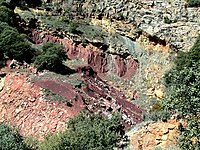Aluminium production in Iverica
This article is incomplete because it is pending further input from participants, or it is a work-in-progress by one author. Please comment on this article's talk page to share your input, comments and questions. Note: To contribute to this article, you may need to seek help from the author(s) of this page. |
| Aluminium Production in Iverica | |
 Part of a Bauxite deposit in Nou Stille | |
| Country | Republic of Iverica |
| Commodity | Aluminium |
| Production | 10.707 million tonnes |
| Value | $25.268 billion standard units |
| Year | 2020 |
Aluminium production in Iverica is significant in supplying Iverica's arms manufacturing industry, aircraft engineering industry, maritime engineering industry, and other heavy industry. Iverican aluminium contributes 30% of the glubal 35.69 million metric tonnes [1]. After Great Xio, Iverica is the second largest producer of aluminium on Eurth, producing 10.7 million tonnes.
Production is largely fuelled by the mining and processing of bauxite in the hilly and mountainous south of the country. Iverican domestic consumption utilises roughly 25% of the 10.7 million tonnes produced per annum. Major importers of Iverican aluminium include the nations in the Federated Commonwealth of New Iberium and the The United States of Prymont.
Despite the relative abundance of bauxite close to surface level, supply is hampered by the presence of cadmium and other impurities. As a result, the industry is highly regulated by a parliamentary Alumina Purity Commission. Higher and more efficient refinement standards have been the focus of Iverican aluminium companies.
As of 2021, pricing benchmarks provided by the Intreimor Metals Exchange (IME), value Iverican Aluminium commodities at a 12-month average of $2,730 Adapton Solidii per metric tonne.
History
The first ventures towards mass production of aluminium were recognised in 1932 following the successive booms in Iverican manufacturing exports. High competition in domestic designers of automobiles, aircraft, and other machinery lead to an increased interest in alternative materials. While bauxite had been mined and processed since the discorvery of earlier conversion processes, demand remained relatively low and stable even decades after the discovery of the Bayer Process.
After the First Argic War in 1954, many factors; including the pre-eminence of Iverica as a military power; and the rising dominance of manufacturers like Toledo Heavy Industries, Arx Arms Manufacturing, and Suisa Aeronautics lead to a surge in investment into larger mines and larger processing plants. The Iverican industry was rapidly developed to the point that the small peninsular country became the number one producer in Argis. Growth continued during the economically buoyant 1950s, and at the end of the decade 3 national companies, AL-Varo, Toledo Metals, and Bauxer were well established with several transnational companies following suite.
The industry faced enormous difficulties after the Second Argic War in the mid 1970's. The rise of the oil price rises in 1972 increased the price of aluminium and negatively affected Iverican exports for several years.
With the stabilising of Prymontian-Russian oil prices in 2018, a better supply-demand balance in the industry, and with new taxation standards for the industry with which some private companies allegedly prefer, several Iverican economists theorise that Iverican aluminium will be much more competitive on the wurld market, likely increasing its export volume and reducing Iverica's burdensome national stockpile.
Production
Deposits
Iverican bauxite deposits are mostly found in the southward hills and mountain faces of Nou Stille. Higher humidity, wind, and weathering in the region make bauxite deposits there much more accessible. Much of the deposits originate from early Miocene ashfall; a product of great volcanic activity from the intraplate hotspot known as the Iverican Plume, which errupted regularly and transformed the archipelagic area into a peninsula more than 20 million years ago.
A controlling interest in Iverican bauxite mining is Bauxer Mining Co. Bauxer is a partially state-owned enterprise operating in Léon, Nou Stille, and Vasqqa D'Oeste. It also operates abroad in Greater Galicia under a transnational subsidiary, Bauxer-Galiciano Co.
Mining
Most Iverican mines extract bauxite through surface mining like open-cut mining or highwall mining. A high presence of cadium in the deposits requires mining companies to maintain a sorting process before extracts are sent to processing plants. Despite high regulation, environmental oversight, and ethical oversight, the intrinsically damaging mining processes have denuded and destroyed large swathes of Nou Stille's once vibrant coastal mountain municipalities. Criticism from private media groups, environmental watch dogs and local NGOs is frequent, leading to occasional court cases. However, these are often met by significant and popular opposition from economic stakeholders and state actors.
Iverican mines extract between 25-26 million tonnes of bauxite per annum. For mines in steeper regions, unprocessed bauxite is transported by cable-lift or truck to nearby processing plants. In Léon, where rivers are more accessible from mines, bauxite from deeper mines there are ferried by river barge to the Léon Industrial District.
Processing
[Bayer Process, purity issues, innovations]
The average waste for aluminium processing in Iverica is estimated to be 2-2.5 tonnes of solid waste per tonne of aluminium produced, largely on-par with wurld averages.
ESG Initiatives
Starting in 2010, the Iverican Ministry of the Environment worked with the Public-Private Partnership Office to reduce the environmental impact of production and increase worker welfare standards. Incentives for non-state operations to include better Personal Protective Equipment and modernise waste management began in 2012 as the first phase in the Environmental Social & Governance goals of the Executive Ministry.


